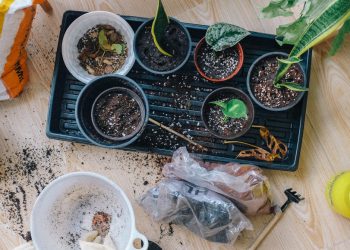 Most gardeners think of lime as an amendment to add to acid soil. This is absolutely true, and we have written about this use in a previous newsletter. But lime is also very beneficial for clay soil, even when acidity is not a problem. In fact, most clay soil is alkaline, but lime can improve its structure and make it more fertile.
Most gardeners think of lime as an amendment to add to acid soil. This is absolutely true, and we have written about this use in a previous newsletter. But lime is also very beneficial for clay soil, even when acidity is not a problem. In fact, most clay soil is alkaline, but lime can improve its structure and make it more fertile.
This all takes place because of a process called flocculation. To understand flocculation, think of a flock of sheep grazing close together in the middle of a pasture when suddenly a thunderclap causes them to scatter in all directions. What had been an impassable mass of grazing sheep is now an open and unobstructed field you could drive straight through because the sheep are now evenly distributed.
When you add lime to your soil, a chemical reaction takes place between the calcium in the lime (which is its primary ingredient), and the particles of clay. When you evenly distribute lime throughout your soil, the fine yet clumped-up clay particles suddenly scatter and bind to the larger calcium particles. Suddenly there is more space between each grain of soilspace that allows both air and water to pass through it more easily.
Some would say the advantage of this is better drainage and aeration, which is true, but there’s something more basic that explains why this chemical reaction is such a great thing for your soil: it creates improved conditions for beneficial bacteria to flourish.
Ken Ferrie, the editor of Farm Journal, explains, The good things you do for your soil are actually aimed at supporting microbial populations. For example, we tend to think we are applying fertilizer to feed crop plants, but those nutrients must be processed by microorganisms and then be released to the plants . . . everything we do to improve soil health is really aimed at building and maintaining this diverse population of soil microorganisms.
In other words, increased microbial action causes the nutrients in the soil to break down and become bio-available, making it easy for your plants to absorb them. It’s as if the microbes cook the soil so that your plants are able to obtain nutritious meals from it. If the soil remains uncooked, your plants won’t digest it well and won’t be able to absorb the necessary nutrients contained in it.
When you add lime, flocculation takes place, which causes the soil to be easier to cultivate and easier to irrigate, and it steps up the action of the beneficial bacteria. Over time, this makes minerals and other nutrients more bio-available, leading to flourishing plants, higher yields, and more fertile soil.
To Lime or Not to Lime
 We wouldn’t want you to miss out on the benefits of lime just because your clay soil is slightly alkaline (with a pH of 7.2 or lower). Yet if it is strongly alkaline (with a pH above 7.2), you would be better off with garden gypsum, which works in a similar way but contains some sulfur that makes it more acidic. For highly alkaline soil you will want to apply sulfur directly. This will help acidify your soil and also protect it from a variety of pests, but it will not bring the benefits of flocculation.
We wouldn’t want you to miss out on the benefits of lime just because your clay soil is slightly alkaline (with a pH of 7.2 or lower). Yet if it is strongly alkaline (with a pH above 7.2), you would be better off with garden gypsum, which works in a similar way but contains some sulfur that makes it more acidic. For highly alkaline soil you will want to apply sulfur directly. This will help acidify your soil and also protect it from a variety of pests, but it will not bring the benefits of flocculation.
So start out by testing the pH of your soil. Tests are very inexpensive these days; in fact, if you buy the Rapitest pH Soil Tester, it costs considerably less than a dollar per test.
If your soil is acidic, neutral or slightly alkaline (7.2 or lower) we recommend you give lime a try. And there is no time better than November for giving your soil a lime treatment. By the time spring comes along, you’ll be all ready for a great growing season.
How to Apply Lime
Applying lime is simple. Just dig up and loosen the soil in some way, either by hand using a spade or a broadfork, or for bigger areas, by using a rototiller. Following the directions on the package, spread the lime either by hand or by using a spreader. Then use a rake or border fork to work the lime pellets into the soil. Don’t worry about the lime pellets not working as well as powdered lime. As soon as they are exposed to water, they will dissolve completely, distributing the lime all through the soil. So the next step is to water your soil using a watering can, garden hose, sprinkler, drip irrigation system, or whatever other method you prefer.
And then just wait until spring to enjoy the increased fertility and improved structure of your soil. If your soil was acidic, you can also expect to see it shift in the direction of being sweeter (more alkaline).
Happy Lime Spreading from all of us at GrowJoy!





No Comments